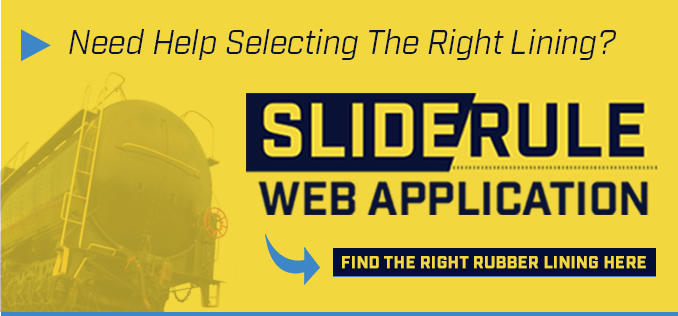HYDROCHLORIC ACID STORAGE TANK – RUBBER LININGS
Hydrochloric acid (hydrogen chloride), or as once named muriatic acid, is a strong, highly corrosive acid. The commercial concentrated or fuming acid contains 38% hydrogen chloride. U. S. P. grades range from 28 to 38%, with 37% HCl being most common.
For storage tanks, tank trailers and tank cars, natural rubber lining on steel has predominantly been used for hydrochloric acid containment. The acid reacts with natural rubber hydrocarbon to chlorinate the surface, making an impermeable membrane. In concentrated hydrochloric acid, it only takes approximately three months for natural rubber crust formations to be in the range of 1/64 (.016″) thickness in depth. This crusting effect makes natural rubber an excellent lining for a hydrochloric acid storage tank. It is also the destructive mechanism of the lining in later years. As surface stress cracks develop the acid penetrates the rubber, forming a new surface crust. The cycle continues until complete lining failure eventually occurs. Lining service performance ranges from 7 to 24 + years depending on lining durometer selection, environmental conditions and vessel stresses. PG-70 has lasted for 25+ years in such conditions and has the longest documented trouble free service.
Through the years, service history has demonstrated that a pure gum natural rubber gives the longest lining life for concentrated HCl. Generally, the lower the durometer, the longer it remains flexible. For example, a 40/45 durometer natural rubber will reach 75/80 surface durometer after three months (PG-70 a 30/35 durometer takes much longer to reach 75/80 and thus nearly doubles the long term lining life); whereas a 60 durometer compounded rubber will be 85/90 Shore ‘A’ durometer. It is that extra hardness that impedes the rubber’s ability to resist flex stresses as found in over-the-road trailers or rail cars. Contrary to pure gum recommendation for concentrated HCl, a 60 durometer natural rubber, VE611BN, is recommended for dilute (5-10%) HCl. In dilute acid service, the compounded natural rubber has less water absorption than gum rubber. Laboratory tests show 6-8 % less water absorption for compounded 60 durometer lining as compared to a pure gum.
Lining examination has shown that the HCl vapors are more detrimental than the HCl liquid itself to lining aging. To improve the natural rubber life in the vapor phase, it is recommended the natural lining be overlaid with chlorobutyl LS582, VE621BC, VE622BCN, or VE625BCN. Chlorobutyl retains its lining flexibility and it is readily adhered to the natural rubber substrate. Chlorobutyl has a greater tolerance to HCl vapors and is less affected from heat aging. The hardness change for chlorobutyl is not appreciable as compared to natural rubber. The reduced hardness yields a more flexible composite to reduce flex cracking.
Also, it has been observed that the natural rubber lining life can be enhanced by painting the vessel exterior white to reflect sun rays. Studies in California have shown 40° to 60°F lower temperature inside tank cars painted white vs. black painted ones.
When spark testing natural rubber lined HCl equipment, a maximum of 7,500 volts is suggested starting point. A test is recommended on a known leak to determine the proper voltage necessary. For food grade concentrated HCl, we recommend our lowest durometer FDA pure gum PG70 over the white loaded FDA natural rubber to increase the lining life. White fillers in natural rubber reduce the physical properties and the higher durometer increases the potential for flex cracking.


